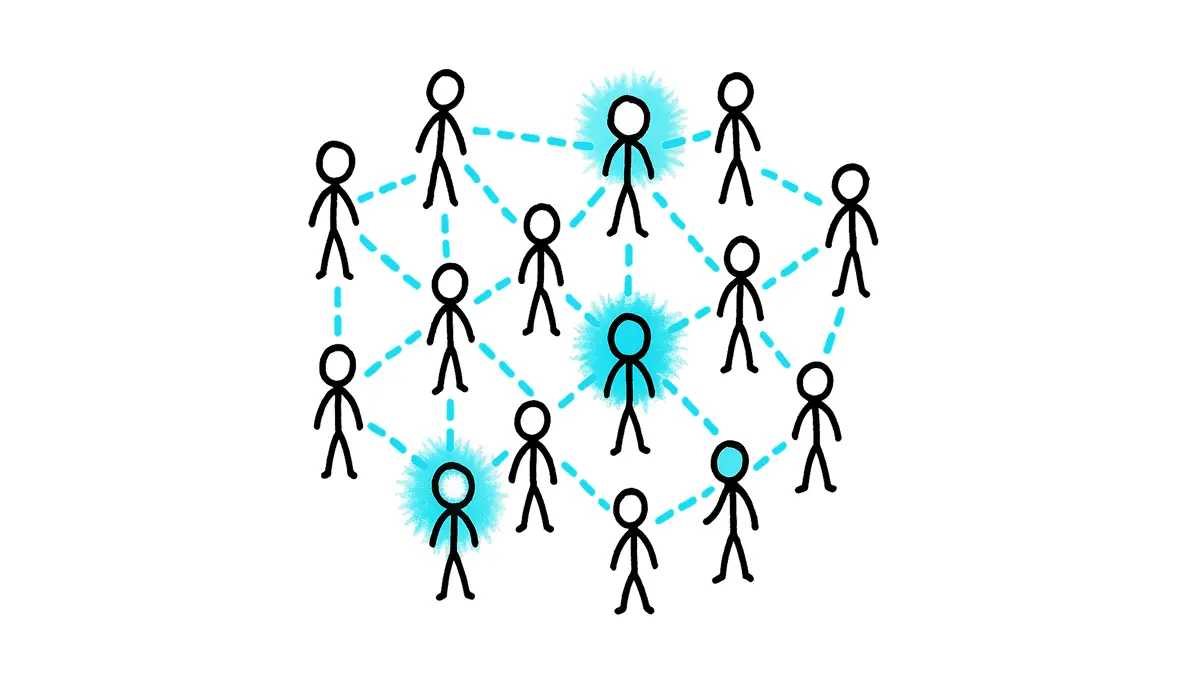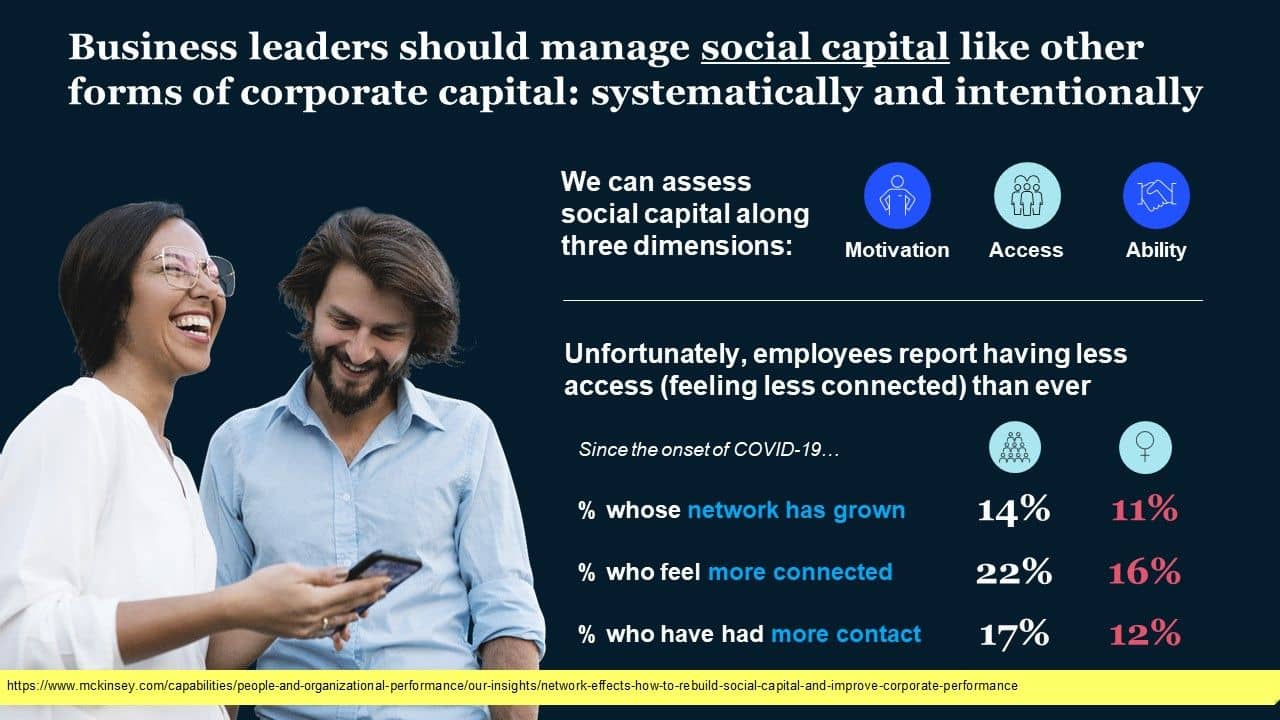Return on Connection

Before the pandemic, execs told me they struggled to build “community.” After the pandemic, many of those same execs mandated office returns in the name of… “community.” 🤔
The terms always sounded strategic, but remained frustratingly vague. If your CEO mandates days in the office to “build community,” how would you even know if it worked?
What these leaders were really talking about (without the language or data for it) was social capital. Not some warm-and-fuzzy cousin of employee engagement, but a tangible organizational asset you can systematically build and track.
Managing (not just measuring) social capital requires cross-functional data integration that few companies have achieved. You need people analytics from HR, collaboration metrics from IT, and spatial data from Real Estate working together. The companies that solve this integration challenge can actually prove whether their office strategy works.
Until then, most are flying blind, and mistaking attendance for connection.
Lead Across the Lines of Modern Work with Phil Kirschner
Over 22,000 professionals follow my insights on LinkedIn.
Join them and get my best advice straight to your inbox.
The Office Data Blind Spot
McKinsey defines social capital as “the presence of networks, relationships, shared norms, and trust among individuals, teams, and business leaders.” Their research also shows its power:
Employees who feel more connected are two times more likely to report higher sponsorship, one and a half times more likely to feel belonging, and one and a half times more likely to be engaged.

Most companies still track revenue per employee without considering relationships per employee, even though it’s the relationships that drive the revenue. The problem isn’t intention; it’s instrumentation.
Just as Atlassian’s cost-per-visit metric reveals hidden office value beyond square footage, social capital metrics reveal the hidden people infrastructure behind breakthrough performance.
It’s Not Culture. It’s Currency.
Last year, The World Economic Forum invoked social capital as a major driver for employees wanting to be in the office, but then equated it to having "frolleagues" (a term I despise), which is not the same thing.

As I said on LinkedIn at the time, "social capital is more business-oriented—because you can manage it systematically like other forms of corporate capital—and research-backed than just connection."
And most companies measure only half the equation: they track digital collaboration through HR and IT systems, unaware of how physical proximity influences relationship formation.
Organizational Network Analysis (ONA) maps collaboration patterns through email frequency, meeting patterns, and communication flows. This tells you WHO connects digitally, but not WHERE or WHY those connections form.
HR holds the people data. IT provides collaboration metadata. Real Estate tracks workspace utilization and meeting patterns, the physical context where many connections form or fail to form. Yet real estate teams are rarely invited into ONA discussions.
As Mitchell Bobman, VP of Workplace Technology at Northern Trust, told me: “Real estate usually gets the short end of the stick when it comes to tech resources.” Which is precisely why most CEOs can’t prove their office mandates are building community.
You're measuring digital social capital while remaining blind to how physical proximity patterns influence relationship formation. Without spatial data, you'll never know if increased office attendance actually strengthened your network or just created more elevator small talk.
👀 It's event season! Will I see you IRL? 👀
- Charter | October 14 | New York City | Learning
- CoDesign | October 21 | San Francisco ✈️ | Speaking 🎤
- Tradeline | October 22-23 | San Diego ✈️ | Speaking 🎤
The Anatomy of Social Capital
To actually prove whether your workplace strategy builds social capital, you need measurement across three dimensions and data integration across all three functions.
Organizations must measure three dimensions:
- Structural capital maps who connects with whom.
- Relational capital measures the quality of trust, safety, support.
- Cognitive capital tracks shared understanding, goals, values, etc.
Together, they form the invisible infrastructure of successful work cultures.
Like workplace proxemics, measuring social capital requires many lenses. No single function owns the whole picture. As McKinsey recently wrote:

That’s the real test for any workplace strategy: does it help people build the networks and trust that make collaboration effortless?
From Rituals to Results
The most successful organizations don’t just engineer connections; they prove their interventions work through coordinated measurement.
Atlassian’s cross-functional hackathons deliberately break silos through quarterly ShipIt events. Teams form across departments to tackle any idea that could make work better. Several major product launches (e.g., Jira Service Desk) trace their origins to these one-day collaborations.
Microsoft’s onboarding buddy program pairs new hires with tenured colleague for their first 90 days. When tracking how often those pairs met, there was a correlation with how quickly employees reached productivity:
- 1 meeting → 56% said their buddy accelerated their productivity
- 2–3 meetings → 73%
- 4–8 meetings → 86%
- 8+ meetings → 97%
More connections = faster ramp-up!

Bank of America’s call-center experiment proved the same principle a decade earlier. By equipping employees with wearable sensors, researchers discovered that staggered breaks limited cross-team interaction. When managers switched to 15-minute shared breaks, call-handling times improved 8–20%, and annual productivity rose by roughly $15 million.
Connection isn’t just cultural, it’s quantifiable.
What made each of these examples work wasn’t a tool or policy, but cross-functional data integration. Atlassian tracked event attendence (RE) and follow-on collaboration patterns (IT). Microsoft combined HR onboarding data with productivity metrics. Bank of America overlaid sensor data (RE) with performance outcomes (Branch Operations).
Each case demonstrates how coordinating measurement across functions lets you prove ROI, not just hope for it.
🎥 One WTC Interview Behind the Scenes 🎥

If you enjoyed my interview for LoopNet's "In the Loop" podcast, check out this bonus footage from One World Trade Center about what makes a workplace magnetic, with some real examples from out the windows.
Shared Data, Shared Outcomes
As Jennifer Hewit, Head of Digital Workplace at Truist, believes:
I don't believe anyone owns experience, I think we're all responsible. And when we put that as our primary objective, the conversation changes because we're not all battling each other, we're actually focused on a shared outcome and a purpose.
That mindset shift from ownership to orchestration is what unlocks value. It means moving beyond functional metrics toward shared organizational intelligence.
First, align the story. Before coordinating interventions, coordinate the narrative. If your HR, IT, and Real Estate leaders can’t agree on one slide that explains your social-capital strategy, that’s your real problem. Misaligned stories make for fragmented data, incoherent investments, and office mandates no one can prove are working.
Then invest in translators. The same data-science capacity that powers parking algorithms can spot patterns across HR surveys, IT collaboration logs, and Real Estate utilization data. Hire or upskill cross-functional experts whose job is to turn those siloed metrics into shared intelligence.
Finally, design for connection systematically. Once measurement is integrated, you can test which interventions actually strengthen networks.
- HR creates manager rituals that build team bonds
- IT builds digital “neighborhoods” to mirror physical layouts
- Real Estate shapes traffic patterns and collision opportunities
Permeable coworking models strike a balance between intentional boundaries and openness to outside perspectives. The result is a measurable lift in both trust and collaboration.
Shared data doesn’t just measure experience. It creates it.
Putting Connection on the Dashboard
Don’t start with interventions. Start with definition.
Start by clearly articulating what stronger connections mean for your organization. New hires building 15+ cross-functional connections within 90 days? 80% of employees have someone to turn to for advice?
Focus on measurable outcomes rather than generic goals. Only then can you determine interventions, establish data-sharing methods, and create a unified narrative for leadership.
That’s how “community” stops being a vibe and starts being a metric.
Trust Is the Real Return
The organizations thriving in the next decade won't be those with the best offices or the most advanced technology. They will crack the code on human connection at scale and build the cross-functional intelligence infrastructure to nurture it systematically.
Social capital isn't soft skills. The companies that treat it as seriously as financial capital, with the same rigor around measurement and cross-functional ownership, will find themselves with employees who genuinely want to be there, collaborate effortlessly, and innovate continuously.
Organizations that learn to measure connection will finally understand what their culture is worth.

Lead Across the Lines of Modern Work with Phil Kirschner
Over 22,000 professionals follow my insights on LinkedIn.
Join them and get my best advice straight to your inbox.


